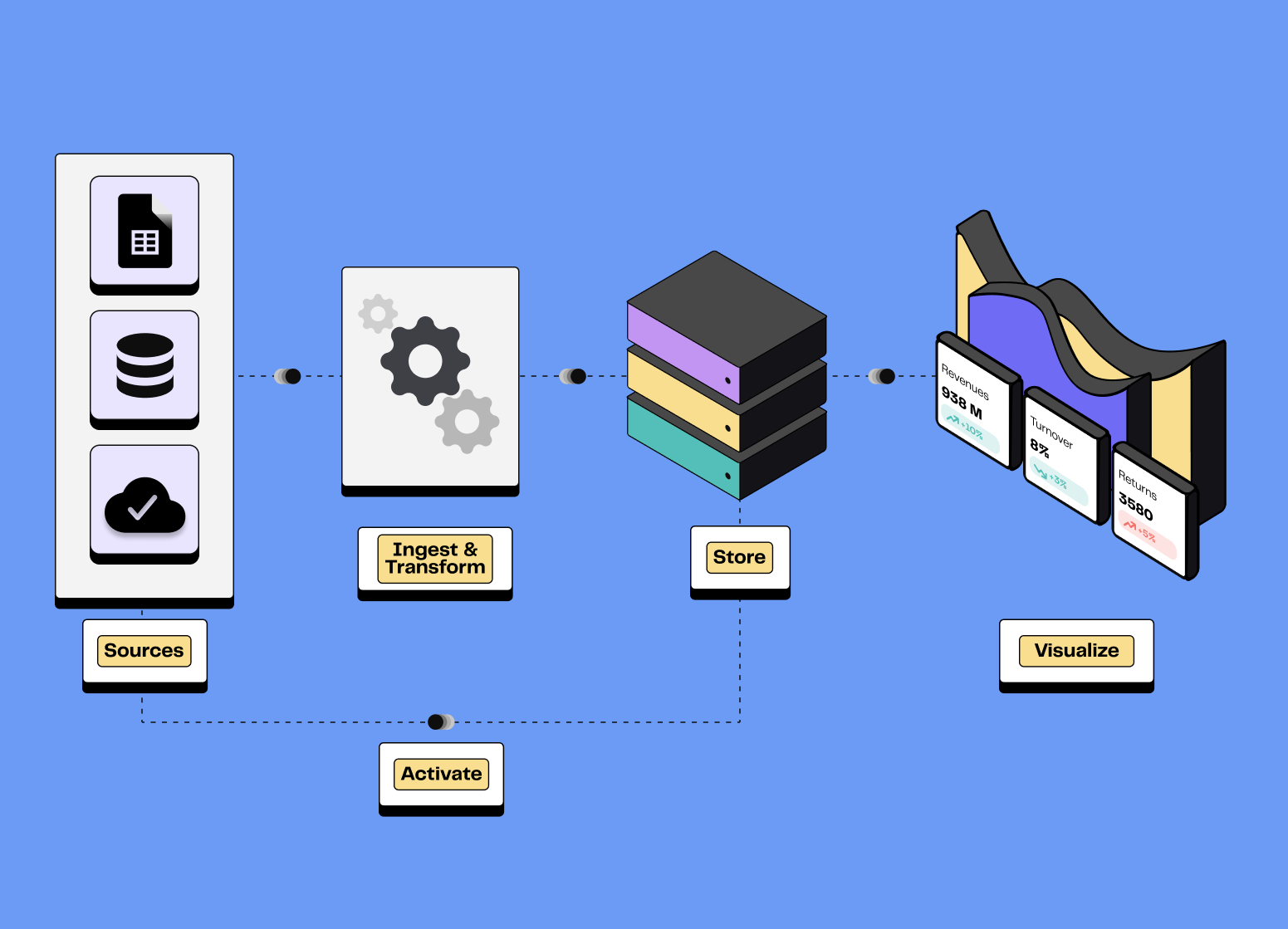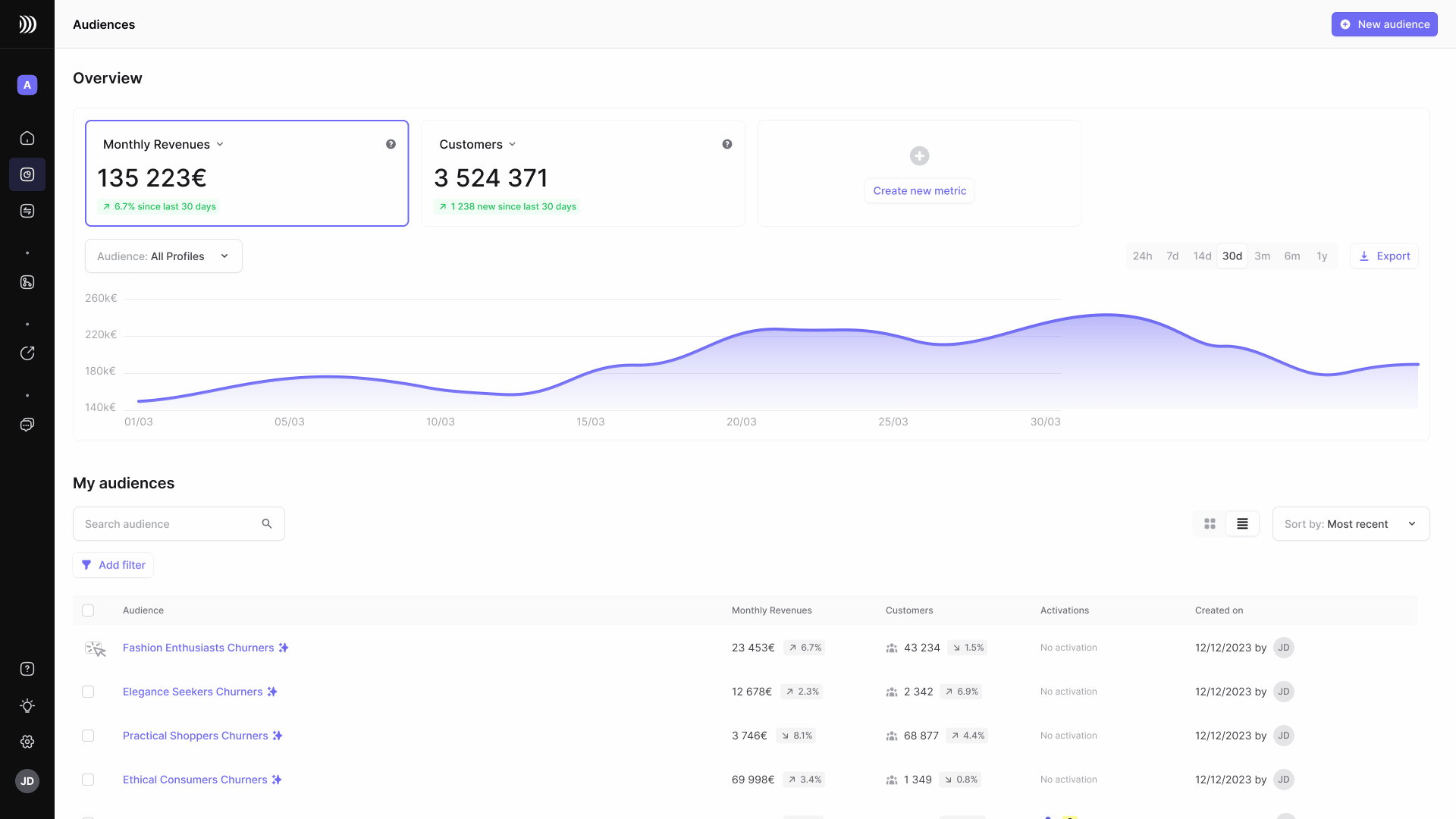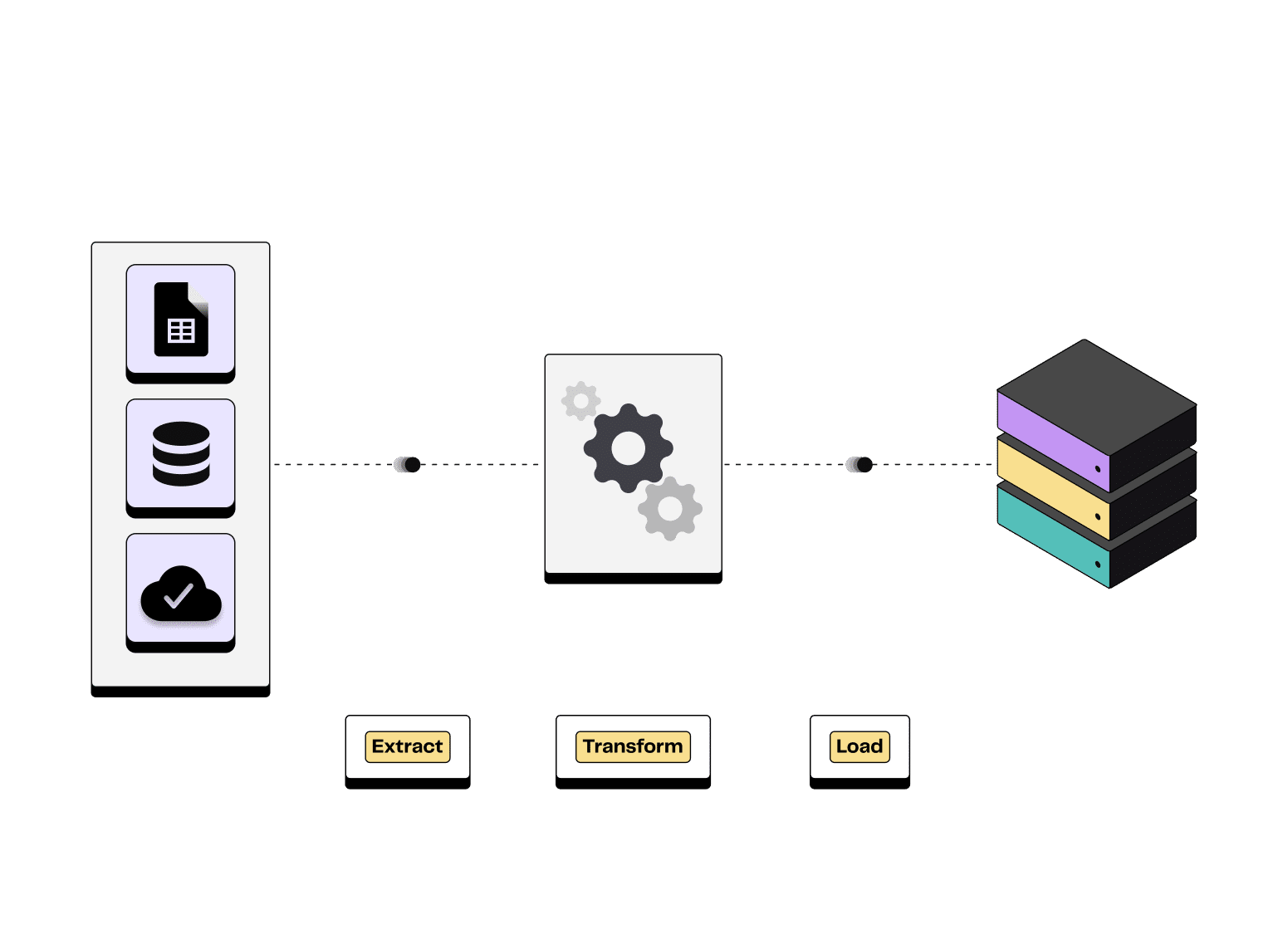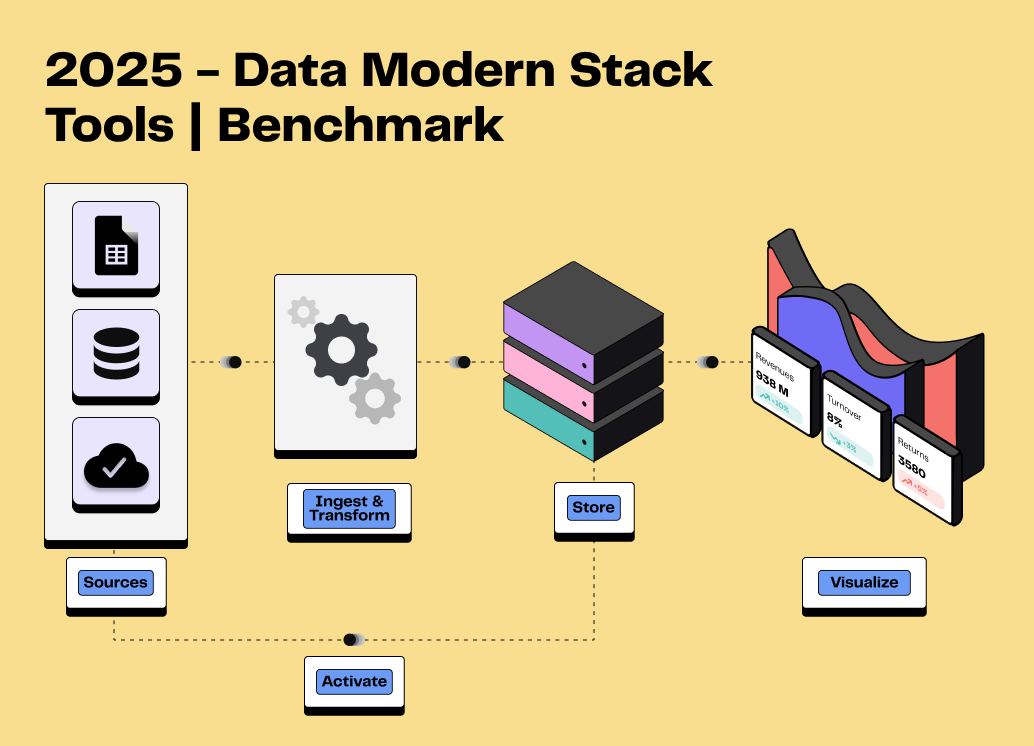
The Data Warehouse is for Marketers
7min • Last updated on May 22, 2025

Alexandra Augusti
Chief of Staff
As marketers or analysts, the challenge of harnessing the power of vast marketing data across diverse platforms and channels is all too familiar... Achieving centralized access to this data is crucial for tracking, measuring, and optimizing campaigns effectively.
🌟 Enter the realm of Marketing Data Warehouses – the solution to these challenges.
A marketing data warehouse is essentially a cloud-based repository designed to consolidate, integrate, and store data from a plethora of marketing sources such as ad platforms, web analytics, CRM systems, and beyond. It provides a structured, scalable environment for housing both historical and real-time data. Beyond mere storage, it facilitates advanced data analysis and reporting capabilities.
With the emergence of the Modern Data Stack, more and more data teams are using a data warehouse to meet their challenges.
👉🏼In this article, we explain why the data warehouse is also useful for marketing teams.
What is a data warehouse?
In the realm of data-driven decision-making, a data warehouse stands as a pivotal entity. It is essentially a sophisticated data management system, crafted to bolster Business Intelligence (BI) efforts, predominantly analytics. At its core, a data warehouse is purpose-built for querying and analysis purposes, housing vast volumes of historical data.
Functioning as central repositories, data warehouses amalgamate integrated data from multiple, often varied, sources. They hold both current and historical data in a singular location, facilitating the generation of insightful reports. This arrangement is particularly advantageous for businesses, as it allows them to delve into their data, extract meaningful insights, and base their strategic decisions on these findings.
For decades, data warehouses have been instrumental in the data architecture of numerous large-scale enterprises.

Yet, the landscape of data warehouses has witnessed substantial evolution, driven by the advent of new data types and advanced data hosting methodologies. Traditionally anchored on-premises, typically on a mainframe computer, data warehouses primarily focused on data extraction from diverse sources, followed by cleansing, preparation, and maintenance of data within a relational database framework.
The narrative, however, is shifting. Nowadays, a data warehouse might find its home on a dedicated appliance or, more notably, in the cloud. This modern breed of data warehouses is not only about data storage; it has expanded its horizon to incorporate analytics capabilities and tools for data visualization and presentation.
"The migration towards cloud data warehouses is gaining momentum, attributed to their compelling advantages over the traditional on-premises counterparts. Cloud-based solutions are heralded for their scalability, elasticity, cost-effectiveness, and enhanced performance.
Capable of accommodating massive volumes of data from disparate sources, they boast rapid query processing speeds."
Oussama Ghanmi, CEO of DinMo
Beyond these technical merits, cloud data warehouses also simplify operational logistics. They negate the need for an elaborate hardware infrastructure, obviating concerns related to setup and maintenance. Furthermore, they offer the convenience of data access from any location, provided there’s internet connectivity.
⚠️ Nonetheless, the journey to adopting a cloud data warehouse is not devoid of hurdles. Challenges such as ensuring data security, upholding data governance, achieving seamless data integration, maintaining data quality, and navigating the intricacies of data migration loom large. To surmount these obstacles and fully harness the potential of a cloud data warehouse, robust strategies spanning data governance, metadata management, platform automation, data movement and replication, data modeling and preparation, and diligent monitoring of the data infrastructure are imperative. Check our guide to overcome these technical challenges when building a data warehouse.

Data Quality Metrics
What are the benefits of a data warehouse for marketing?
In today's fast-paced business world, marketing teams are under constant pressure to produce results. With so much data available to them, it's easy to become overwhelmed and struggle to find the insights they need to make informed decisions.
That's where a data warehouse can come in. By building a centralized repository for all of their data, marketing teams can streamline their processes, gain deeper insights into their customers, and ultimately drive better business outcomes.
Improving data consolidation
One of the key benefits of a data warehouse is that it allows marketing teams to consolidate all of their data in one place. This includes data from various sources, such as customer data, website analytics, social media metrics, and more. By bringing all of this data together, marketers can gain a more comprehensive view of their customers and their behavior, enabling them to make more informed decisions about how to reach and engage with their target audience.

Customer 360, centralising all customer data
Your CRM can easily answer questions like “How many forms were downloaded in September?” and you can quickly see the conversions associated to a campaign running on Meta in your Business Manager. However, the platforms' attribution models are already biased, their aim being to promote themselves as much as possible. But that's not the biggest problem. If you want to answer a question like "What explains the increase in the churn rate last month?", you need to have the big picture.
With a data warehouse, you no longer need to look at several tools to find information about a customer.
Simplifying data analysis
Another benefit of a data warehouse is that it allows marketing teams to analyze their data in more detail. With a centralized repository for all of their data, marketers can easily query their data using a range of tools and techniques, such as SQL or data visualization software. No need to look at different dashboards that didn't have the same data to understand the complete customer journey.
This enables them to uncover insights that they may not have been able to find otherwise, such as patterns in customer behavior, preferences, and demographics.
⚠️ Many marketers don't necessarily know how to code and analyse their data. Historically, this work was done by data analysts. However, the emergence of technologies based on artificial intelligence has made it possible to develop AI co-pilots, who can answer any business question. Access to data has been more and more democratized for everyone, making businesses even more data-driven.
Reducing data silos
But the benefits of a data warehouse don't stop there. By building a centralized repository for their data, marketing teams can also improve their collaboration and communication with other departments within the company. For example, they can share their insights with sales teams, who can use the data to tailor their approach to specific customers and close more deals. They can also work more closely with product development teams, who can use customer data to inform their product roadmaps and prioritize new features.
Your data warehouse becomes your single source of truth and so everyone in your business has the same data and metrics to work with.
Improving marketing results
In addition, a data warehouse can also help marketing teams to improve their ROI. By having a better understanding of their customers and their behavior, marketers can make more informed decisions about where to allocate their resources. For example, they can identify which marketing channels are driving the most conversions and invest more heavily in those channels. They can also identify which customer segments are the most profitable and focus their efforts on those segments.
Moreover, a data warehouse can easily be connected to any business tool, enabling centralized and enriched data to be used in the final platforms. This makes it possible to put in place various use cases, in particular for audience strategies (retargeting, exclusion, lookalike, observation) and CRM enrichment.

One-click activation
Improving efficiency
Finally, a data warehouse can also help marketing teams to improve the overall company efficiency. By consolidating all of their data in one place, marketers can save time and reduce the risk of errors associated with manual data entry and reconciliation. They can also automate their data collection and analysis processes, freeing up more time to data teams to focus on strategic initiatives.
Marketing Data warehouse benefits - Wrapping up
In short, a data warehouse has three attributes that marketers should prize:
Completeness:you can build a complete picture of your customers and use your data warehouse as your single source of truth
Flexibility: The cloud data warehouse is flexible and you can structure your data as you want. CDPs and CRMs have rigid data models like users/contacts and “events”, but in reality, every business is unique. That’s why we always recommend using a Composable CDP, which is based on your data warehouse.
Efficiency: Your data has already invested in your data warehouse. By using the data already available in your data warehouse to unlock more growth, you’re making these investments even more worthwhile.
How to choose the right data warehouse for your company?
The landscape of data warehousing is evolving rapidly, reflecting an increasing acknowledgment of its importance in unlocking the potential of business intelligence and analytics.
💡 A Market Research Future report projects the global data warehouse as a service market to soar to USD 8.79 billion by 2030, marking a robust compound annual growth rate (CAGR) of 21.9% from 2023 to 2030.
Selecting the most fitting data warehouse for your organization is a significant decision, fraught with complexities. Critical considerations include the size, type, and complexity of your data, alongside the data warehouse's scalability, performance, cost, maintenance requirements, and how well it integrates with your existing systems and applications.
To navigate through the myriad of options, here are essential criteria to guide your selection process:
Cloud vs. on-premise storage: The debate between cloud-based and on-premise data warehouses is pivotal. In our opinion, cloud solutions offer scalability, elasticity, cost-efficiency, and superior performance.
Tool ecosystem: The ecosystem surrounding your data warehouse is crucial; this includes data sources, integration tools, analysis tools, visualization tools, and governance tools. Opt for a data warehouse that seamlessly integrates with your existing or planned tools, providing a comprehensive suite of features and functionalities to fulfill your data needs.
Implementation cost and time: Implementation is a critical factor, encompassing planning, design, development, and deployment phases. The goal is a data warehouse that is straightforward to implement and manage, sparing you excessive technical complexities or resource demands. Evaluating different providers' pricing models and plans is necessary to ensure you're obtaining the utmost value.
Ongoing costs and maintenance: Consideration of the data warehouse's long-term financial and maintenance obligations is paramount. This includes storage, compute, data transfer, and support fees. Look for solutions that are efficient and transparent in pricing, avoiding any hidden charges, while ensuring reliability and security plus regular updates to adapt to the evolving data landscape.
Ease of scalability: As your organization's data volume and complexity grow, so does the need for scalable data warehousing solutions. Ideal data warehouses can manage vast datasets from diverse sources with high query speeds and adapt their capacity according to your evolving needs without sacrificing data quality or accuracy.
By carefully weighing these criteria, you can select a data warehouse that aligns with your company's goals, facilitating effective and efficient data storage, management, and analysis. Most commun data warehouses include Google BigQuery, Snowflake, Amazon Redshift or Microsoft Azure Synapse.
💡 Our recommendation is simple: if your stack already uses Google products, opt for Google BigQuery! Otherwise, turn to Snowflake.
How to build a data warehouse?
⚠️ This project must be led by the data team, as marketing teams usually cannot build their data warehouse alone.
Embarking on the journey to build a data warehouse is no small feat. It entails a series of meticulous steps including planning, designing, development, testing, and deployment. When executed with precision, the outcome can significantly bolster the capabilities of your marketing team and, by extension, elevate the overall value of your business.
Here are essential steps to consider in the pursuit of constructing an effective data warehouse:
Define your business requirements. Initiate by gaining a clear understanding of the objectives your data warehouse seeks to achieve, the type of data it will house, and the analytics it needs to facilitate. Identifying key stakeholders, users, and data sources is critical, as is prioritizing use cases and features. This foundation will guide the entirety of your project.
Choose your platform and technology stack. The next critical decision involves selecting the hosting environment for your data warehouse and deciding on the appropriate tools and technologies. Factors such as scalability, performance, security, cost, and how well they integrate with existing systems and data sources should influence your choice. Cloud-based data warehousing options like Google BigQuery, Amazon Redshift, or Microsoft Azure Synapse Analytics warrant careful consideration. See previous section for more information on that step.
Design your data model and architecture. This phase focuses on crafting the logical and physical structure of your data warehouse and its integration points with both data sources and consumers. This step involves defining dimensions, facts, measures, and hierarchies and structuring the data warehouse architecture, which includes the data lake, the ETL process, the relational database, and data marts.
Choose your ETL pipeline and load your data. Implementing an efficient process for extracting, transforming, and loading data from various sources into your data warehouse is paramount. Utilizing an ETL tool can help automate this process. Ensuring data validation, cleaning, and standardization before it enters your data warehouse is essential for maintaining quality.

Extract Transform Load process illustration
Develop your reporting and analytics capabilities. Empowering users to access, analyze, and visualize the data is a crucial step. Leveraging BI tools such as Tableau, Power BI, or Looker enables the creation of insightful reports and dashboards. Providing capabilities for users to query the data using SQL or other languages, and to engage in more sophisticated analytics like machine learning, is also vital.
Implement ongoing maintenance and optimization. The final step underscores the importance of regular upkeep to ensure the data warehouse operates optimally and continues to meet evolving business needs. This involves monitoring performance, availability, and data quality, addressing any emerging issues, and continuously updating and refining the data warehouse to incorporate new features and improvements.
By adhering to these meticulously outlined steps, you can construct a data warehouse that not only consolidates and analyzes your marketing data but also unlocks invaluable insights and opportunities for your business growth.
Conclusion
By building a centralized repository for their data, marketing teams can gain deeper insights into their customers, improve their collaboration with other departments, improve their ROI, and improve their overall efficiency. In today's hyper-competitive business environment, these benefits are more important than ever. By investing in a data warehouse, marketing teams can position themselves for success in the years to come.















